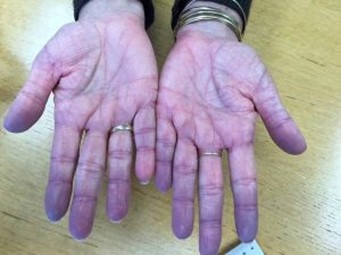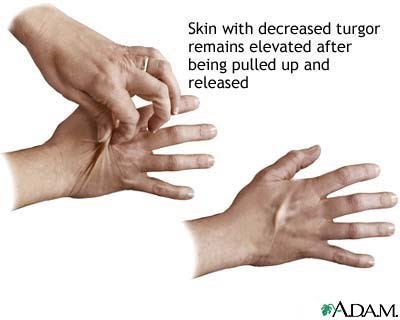A nurse is performing a head to toe assessment on a client. Which of the following assessment findings would the nurse recognize as requiring an immediate action and would be the first priority when addressing a patient health problem?
Pallor.
Jaundice.
C. Cyanosis.
Erythema.
The Correct Answer is C
The correct answer is choice C. Cyanosis. Cyanosis is a medical emergency and requires immediate action by the nurse. It indicates that the client is not receiving adequate oxygenation and can lead to respiratory failure if not addressed promptly. Pallor (Option A) and erythema (Option D) are concerning but are not immediate priorities compared to cyanosis. Jaundice (Option B) may indicate liver dysfunction but is not an immediate priority unless it is associated with other symptoms such as severe abdominal pain or altered mental status.

Nursing Test Bank
Naxlex Comprehensive Predictor Exams
Related Questions
Correct Answer is D
Explanation
The correct answer is choice D. Identify the five major drug side effects before discharge tomorrow. This is a measurable goal as it has a specific action, which is to identify five major drug side effects, and a specific time frame, which is before discharge tomorrow. The goal is also realistic and achievable within the given time frame. Option A, sitting out of bed in the chair, is not specific enough and lacks a time frame. Option B, verbalizing feelings about surgery at some point, is too vague and lacks a specific action and time frame. Option C, eating low-sodium food, is specific but lacks a time frame and may not be realistic given the client's condition.
Correct Answer is C
Explanation
The correct answer is choice C: Skin fold returns to its usual shape quickly when released. When assessing skin turgor, the nurse is checking for the elasticity and hydration of the skin. In a normal assessment, when the skin fold is lifted or pinched, it should return to its usual shape quickly when released. This indicates good skin turgor, which is an indication of proper hydration. If the skin fold is difficult to lift or pinch (choice A), this indicates poor skin turgor and possible dehydration. If an indentation of 2 mm remains after releasing the skin fold (choice B), this indicates poor skin turgor and possible dehydration. If the skin fold returns to its usual shape slowly when released (choice D), this may indicate a decrease in skin elasticity and possible dehydration.

Whether you are a student looking to ace your exams or a practicing nurse seeking to enhance your expertise , our nursing education contents will empower you with the confidence and competence to make a difference in the lives of patients and become a respected leader in the healthcare field.
Visit Naxlex, invest in your future and unlock endless possibilities with our unparalleled nursing education contents today
Report Wrong Answer on the Current Question
Do you disagree with the answer? If yes, what is your expected answer? Explain.
Kindly be descriptive with the issue you are facing.
